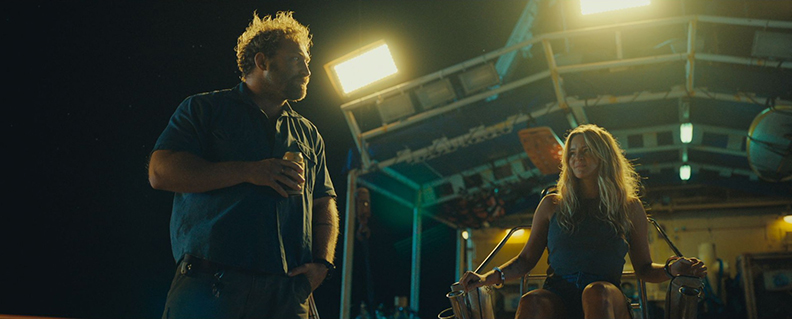
Predator Versus Prey, but Not How You Expect
Dangerous Animals
MOVIE REVIEW
Dangerous Animals
-
Genre: Horror, Thriller
Year Released: 2025
Runtime: 1h 33m
Director(s): Sean Byrnes
Writer(s): Nick Lepard
Cast: Hassie Harrison, Jai Courtney, Josh Heuston, Ella Newton, Liam Greinke, Rob Carlton, Ali Basoka, Michael Goldman, Carly Haynes, Dylan Eastland, Jon Quested, James Munn
Where to Watch: exclusively in theaters on June 6, 2025
RAVING REVIEW: What happens when a movie uses its setting not as an escape but as a cage, and reimagines the shark genre without relying on the shark as the villain? That question powers DANGEROUS ANIMALS, a genre blend that swims past surface-level thrills and aims for something more introspective. This story isn’t built around blood-in-the-water suspense but anchored in the deeper tensions of control, obsession, and the illusion of safety.
The plot may revolve around a captive situation and a boat adrift in predator-filled waters, but the real danger isn’t circling below—it’s standing a few feet away. Zephyr (Hassie Harrison), who appears to live freely as a nomadic surfer, gradually becomes the lens through which the film explores the gap between appearance and reality. An unspoken emotional stagnation undercuts the freedom of sleeping under stars and driving wherever the wind blows. The ocean, once her sanctuary, becomes a trap.
Zephyr’s story isn’t about losing freedom but realizing she never had it. Her world of sun, surf, and solitude unravels when she crosses paths with Tucker, a man whose shark obsession runs deeper than admiration. He doesn’t come across as a classic villain but more like someone whose twisted purpose is a belief system. He positions himself as a protector of nature, but the line between reverence and control quickly blurs. That contradiction lies at the film's heart, making him less of a monster and more of a warning.
DANGEROUS ANIMALS turns its attention inward. The real horror lies in Tucker’s delusion and Zephyr’s forced reckoning with herself. The duality between each trapped in their own way forms the core of the story’s psychological weight. Director Sean Byrne and writer Nick Lepard retooled the script to emphasize these emotional undercurrents, creating a story that breathes unease rather than screams it.
That sense of quiet unease is embodied in the film’s casting. Harrison brings depth to Zephyr and never feels forced or exaggerated. Her portrayal avoids the genre’s usual pitfall of turning survivors into superheroes. Instead, she reacts with fear, frustration, and eventually, agency. She doesn’t transform into someone else—she stops running and becomes herself. It’s a subtle arc that hits harder for being grounded in vulnerability rather than defiance.
Across from her, Jai Courtney delivers a performance that resists the urge to go big. His portrayal of Tucker isn’t a boogeyman—he’s methodical, unsettling, and most terrifying when he believes he’s doing the right thing. Courtney balances menace with humanity, allowing glimpses of the broken man beneath the violent shell. The power of his performance lies in what’s hidden, not revealed. That ambiguity lets the character breathe, keeping the audience constantly uncertain of what he might do next.
Rather than sensationalizing shark encounters, the film downplays them. Real shark footage is blended with the actors’ scenes, not to scare but to remind us of their place in the ecosystem. The predators don’t attack—they exist. In doing so, they become a quiet contrast to the true predator. This approach flips the usual expectations, using restraint to make a broader point about the stories we choose to tell.
The sound design deserves particular praise. The score isn’t there to signal every dramatic moment. It moves with the characters, enhancing the psychological unease rather than dictating it. Working with the film's soundscape, the audio becomes another manipulation tool, sometimes subtle, sometimes overwhelming, always calculated. It supports the mood without drawing attention to itself.
The story unspools like an open wound, refusing to close until the characters have faced everything they’ve been avoiding. And that’s where the film finds its strength—not in spectacle or shock value, but in its quiet interrogation of what it means to be trapped. It doesn’t ask audiences to root for a hero or fear a monster. It invites them to sit with uncertainty and recognize that the things we fear are often less threatening than the ones we worship. Turning the camera away from the expected dangers and onto ourselves reframes the narrative of survival in a way that feels both familiar and unsettlingly fresh.
Please visit https://linktr.ee/overlyhonestr for more reviews.
You can follow me on Letterboxd, Instagram, Twitter, and YouTube. My social media accounts can also be found on most platforms by searching for 'Overly Honest Reviews'.
I’m always happy to hear from my readers; please don't hesitate to say hello or send me any questions about movies.
[photo courtesy of IFC FILMS, SHUDDER]
DISCLAIMER:
At Overly Honest Movie Reviews, we value honesty and transparency. Occasionally, we receive complimentary items for review, including DVDs, Blu-rays, CDs, Vinyl Records, Books, and more. We assure you that these arrangements do not influence our reviews, as we are committed to providing unbiased and sincere evaluations. We aim to help you make informed entertainment choices regardless of our relationship with distributors or producers.
Amazon Affiliate Links:
Additionally, this site contains Amazon affiliate links. If you purchase through these links, we may receive a commission. This affiliate arrangement does not affect our commitment to honest reviews and helps support our site. We appreciate your trust and support in navigating these links.